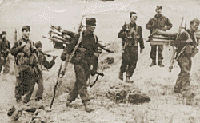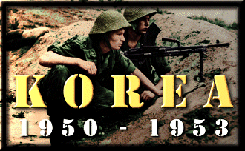A Rude Awaking
Ex Argyll Pat Quinn Remembers Hill 282
Hill 282 was supposed to be a surprise for the North Koreans but it was more of a surprise for the Argylls who were ordered to take it. When the hill was taken the Argylls found themselves under fire from another hill and with out fire support. That was until the UN planes returned and blasted their own positions instead of the enemy!
'I've never seen anything as bad, even as a fireman", said Pat Quinn an Ex-Greater Manchester Fire Brigade fireman who was on Hill 282 that terrible day'.

Myself, Alan Barton and the rest of 27th Brigade, had an ecstatic send-off from Kowloon and the Hollywood style welcome at Pusan that became just a memory all to soon. By September the 23rd 1950 we had crossed the Naktong River in the breakout from the Pusan perimeter. A few days earlier the American Marines had landed at Inchon further north and were driving towards Seoul. Now the Argylls were facing a strongly held North Korean position called Hill 282 on the military maps. We were told that the attack was to be a surprise with no artillery softening up or pre-aerial bombardment to give the enemy a rude awaking.
B Company was chosen to lead the assault with C Company hard on their heels. The hill was steep and covered with scrub, loose rocks and fir trees The North Koreans were not used to being attacked at 5am and the leading Argyll's were able to get within fifty yards before making their charge. Recovering quickly from the initial shock the North Koreans opened up with everything they had and killed the leading platoon commanders, among others.
It was at this stage that we went into a classic copybook Highlander charge, yelling like banshees, and used our rifles and bayonets to clear the North Korean positions. It was too much for the North Koreans and those who were left alive left the scene. We had taken Hill 282.

There was no rest for us however. Hill 388 on which the North Koreans were well positioned over looked Hill 282 from the side of the saddle. They started to shell us and we were soon pinned down. Urgent calls were made for artillery support, but there was none to be had. Some nameless Napoleon far behind the lines had ordered the gunners elsewhere and left us high and dry with no fire support. Our second in command, Major Kenny Muir, led a party of stretcher-bearers up the hill to try and evacuate some of the wounded. Instead he found himself taking command of what was now a desperate defence. Major Muir asked for an air strike on the North Korean reserves that could be seen moving up to the left of our position. After getting confirmation that an air strike was on it's way, the Major made sure that our positions were clearly marked from the air by using crimson and yellow recognition panels.
Shortly after 12 noon three American P-51 Mustang aircraft appeared. We all cheered at the sight of these aircraft feeling that the odds were now in our favour. Our cheers soon turned to horror as the American aircraft ignored our recognition panels and swept down on our positions with all guns blazing killing many Argylls. The aircraft then circled once and came back in for another run. This time they dropped deadly Napalm bombs on us.

As this death by friendly fire was taking place a number of Argyll's were climbing up the hill with much needed ammunition. Among them was Alan Barton of HQ Signals. Later he was to go up again to help bring down the wounded and dead.
The Argyll's were shot and barbecued and blasted off our hill. The 35 survivors of the American air strike rallied together and led by Major Muir we managed to reoccupy the still burning hill. Sadly Major Muir was killed while helping to fire our mortar. His courage was a great help to us and he was later awarded a Victoria Cross for his bravery on that day.
With all our ammunition all gone and scarcely a man still unwounded, it was time to leave the hill. The battle - exhausted survivors came down the hill carrying or dragging the wounded. I was so badly wounded that I could not walk and had to be dragged down the hill, but at least I was still alive.

The worst part of it all was the Napalm. Even as a fireman I have never seen any thing like the destruction that stuff does to human skin. I never want to hear of that stuff being used again.
I spent a long time in hospital recovering from my wounds before I returned to the Regiment. By then the war had moved on and the United Nation forces had pushed the North Koreans almost to the Yalu River and it looked as though the end of the war was in sight. But on the other side of the Yalu River was Red China.
It was cold. I've never felt so cold before or since. Blood numbing. Without the American special warm clothing we were issued the British troops would have frozen to death. The battle dress and ammo boots we normally wore were not made for Siberian winters. The most warming thing was the thought of a return home or to garrison life back in Hong Kong. But that was to remain only a thought, for in October the Chinese entered the war.

Attacking in hordes or in small fast-moving groups the Chinese forced the transport bound Americans into retreat jamming the roads with their seemingly limitless vehicles. Perhaps it was intended as a compliment when an American General asked for the British 27th Brigade as a rear guard for this retreat. The Argylls, the Middlesex, and the Australians had their own opinions. We didn't suffer many causalities during the retreat because unlike the Americans, who were tied to the roads, we moved anywhere on our two feet and got there.
I left the Army in 1952 after my time expired plus one for the Queen (a regular soldiers way of saying he had completed his time with the colours with an additional year). I joined the Salford Fire Department in 1956. Not so long ago I managed to get back in touch with Alan Barton after all those years.



